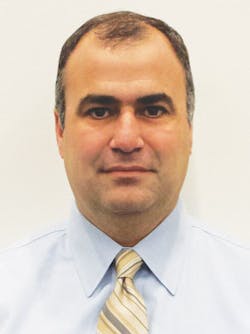CS Connection
As procedural volumes grow, along with the complexity of surgical instruments and scopes, the demands on central sterile/sterile processing departments (CS/SPD) become even greater. In an effort to improve efficiency, quality and compliance, healthcare organizations are turning to offsite sterile processing operations where they can leverage a centralized CS/SPD team, space, equipment and processes for multiple facilities.
But with opportunity comes risk. The move to offsite sterile processing presents a whole new set of challenges to compliance, quality and safety beyond what CS/SPD professionals face within the four walls of an in-house department. Considerations include communication between the offsite CS/SPD and the facilities it serves, compliance with industry standards and manufacturer instructions for use (IFU), safe transport of instruments to preserve the sterility of clean instruments and avoid cross-contamination, and effective tracking to ensure instruments are available for clinicians when they need them.
Adherence to policies, procedures and standards
The establishment and implementation of policies and procedures aligned with industry standards and IFUs are critical to the safe and effective handling of instruments whether the CS/SPD is located on or offsite. These include those that apply to traditional in-house sterile processing departments, such as Association for the Advancement of Medical Instrumentation (AAMI)/American National Standards Institute (ANSI) ST79:2017 and Occupational Safety and Health Administration (OSHA) regulations, as well as industry transportation standards.
“Spending the time and effort upfront is critical to ensure the offsite staff have the necessary tools and information required to do their job and meet all standards and IFUs,” said Kimsey. “While this is an extremely time-consuming effort, we’ll be able to reap the rewards and benefits when we load the information into our instrument management system. The staff will be able to scan the tray at the sink in decontamination and have the instructions for cleaning appear on the screen. No more relying on memory or an in-service training months ago. Bringing the right information to the technician at the right time in the right location is critical.”
Communication
It is challenging enough managing communication between the CS/SPD and operating room (OR) when the instruments remain inside of a facility. Transporting instruments offsite for processing and then getting them back to the right facility at the right time requires a strong communication network and collaborative teamwork.
Communication channels must also be open to keep offsite processing staff up to date on new policies, procedures, industry standards and manufacturers’ IFUs.
“A major component to consider implementing and clearly indicating to your personnel is the mode of communication and the channels through which to distribute your policies,” said Seavey. “Communicating with offsite personnel is a key component to policy conceptualization. Recognizing and incorporating strategies to uphold OSHA regulations, transportation vehicle regulations, and other applicable compliance regulations are factors in ensuring a strong communication system is in place and IFUs are followed correctly each time.”
“Consistency in communication is key to the success of any and all sterile processing departments regardless of where the personnel are located,” said Lane. “Having certified sterile processing personnel at both locations is a key part of ensuring compliance to the processes and the following of IFUs.”
Pre-cleaning
According to Ferriero, instrument pre-cleaning or point-of-use cleaning is even more critical for offsite reprocessing because the length of time for transport and receiving of instruments into decontamination can vary, causing significant delays in reprocessing. He states:
“Choosing a good product for pre-cleaning is even more important in the clinic setting. While products with surfactants are adequate, having a pre-cleaning agent with an enzymatic foam is ideal especially in situations involving GYN and orthopedic clinics where there is generally a higher level of bioburden on the instruments.”
Anbari notes how flexible endoscopes present specific challenges in this area, stating:
“Contaminated transport of flexible endoscopes presents greater challenges than instrumentation that can simply be kept moist until decontaminated. Endoscopes used in the morning that may wait for an afternoon transport pick-up will most certainly fall into delayed cleaning conditions putting them at greater risk for biofilm development. Use of approved 1 to 72 hour delayed cleaning enzymatic foam, designed for contaminated flexible endoscope stasis, may need to be employed.”
Transportation
“When transporting between facilities the process becomes much more in-depth and requires the organization to take a much broader look at the following areas: Containment devices, the transport vehicle, temperature control in the vehicle, temperature changes, loading of the vehicle inclusive of separating clean from dirty and cleaning of the transportation vehicle,” said Lane.
She says the most important rule of thumb when transporting and/or storing devices within or between facilities is to ensure adherence to AAMI ST 79 (2017) Section/Chapter 6, specifically 6.4, 6.5, 6.5.6, and 6.5.7 for transportation; as well as, Section/Chapter 11 specifically 11.3 and subsection 11.3.5 for storage.
“The transportation and storage of devices within or between facilities is a major ‘hot topic/button’ for the surveyors from The Joint Commission,” said Lane. “As concern focuses more and more on the sources of healthcare-acquired infections (HAI) it seems as though regulatory agencies are focusing more in depth on how we are storing and transporting our medical devices.”
Kimsey says preparation for transportation starts in the OR, where the staff must return the instruments to their correct tray, ensure they are kept moist, and ensure they are adequately protected.
“Transporting devices to offsite facilities follows both standard recommendations and common sense,” said Kimsey. “Containerized trays can travel within their container, but we’ve found extra benefits in placing them in clear see-through plastic sealed bags labeled biohazard or ‘dirty.’ Wrapped trays can also be sent offsite but need to be placed inside a plastic sealed bag as well. Sterile items should be completely cool before transporting inside a plastic bag.”
Transporting instruments, whether it is across the street or across miles of roads from a centralized processing center to a healthcare facility, presents special considerations from a container perspective. Container selection must take into account the containment of dirty instruments, the preservation of clean instruments, and prevention of damaged or missing instruments.
“Customized trays that separate and secure delicate items are important,” said Anbari. “Each outer container will need to be examined closely to ensure internal space is not so tight as to risk damage to sterile barrier while fitting sufficiently to not allow too much shifting space. Containment may require additional padding, belt/corner guards, or packaging depending on tray type. Much examination must be done in advance to achieve success for each transport scenario and all tray types.”
“Instruments should be transported in a sealed container designated for dirty contaminated items with the container clearly labeled as such,” said Ferriero. “There are great options on the market, I prefer the ones that can be latched and securely locked for safe transport. It should also be deep enough to allow for sufficient pre-cleaning.”
“Special transportation carts should be utilized as well with heavy duty casters, adjustable shelves to limit the amount of movement of items being transported, and sealed doors to stop contaminants escaping when transporting dirty [items], or contaminants from entering when transporting sterile items,” Kimsey added. “The transportation vehicle should limit exposure to extreme heat or humidity and regular testing of the environmental conditions inside of the transportation carts should be conducted.”
Instrument tracking and chain of custody
Tracking the flow of instruments to and from the offsite processing center is critical to inventory management, procedural scheduling, instrument maintenance and documenting the chain of custody.
“Instrument tracking systems can be valuable resources to track instruments and devices from offsite clinics through the entire sterilization and delivery process,” said Ferriero. “If an instrument tracking system is not feasible, a manual system for capturing offsite equipment receipt and delivery should be implemented. Equipment repair and damage is another issue facing the reprocessing of offsite devices: Damaged equipment needs to be identified and communicated to equipment owners immediately upon receipt and inspection of equipment so that suitable action can be taken to get equipment repaired in a timely fashion.”
Anbari notes the importance of maintaining the chain of release from origination, transport and delivery, stating: “For sterile items projected and real time scheduled needs feed the system for preparation. Internal instrument tracking and usage platforms are a necessity.” He describes the following process:
1. The technician loading the tray should confirm the tray items list/count and that all preference parameters have been met. If multiple trays for one order are needed they should be packed together and kept together.
2. The courier should receive a packet that that enables confirmation that all containers are accounted for.
3. Upon delivery the receiving facility should have secured storage space that complies with sterile storage requirements where they carefully confirm the tray count and type by minimally invasive/handling process.
4. A copy of the tray contents should be left with the facility so notes may be added for underperforming, incorrect or missing instruments.
5. After point of use cleaning and moistening prep, additional containers for separating sharps may be needed for return to the centralized unit. These additions would need to be noted on the return paperwork since the container count out may be larger than the inbound count.
6. Additionally, if a using facility completes decontamination at their own site and returns items just to be sterilized, the location that will sterilize the tray needs to confirm and document the condition, count, and requirements of the tray have been met prior to sterilizing. Thus the return paperwork will need to contain this documented confirmation.
Documentation and data-driven decisions
As Lane states, “If you didn’t document it, you didn’t do it.” Proving compliance with policies, standards and regulations requires the healthcare facility to document all stages of instrument handling and processing, both onsite and offsite, including staff training.
“Regardless of the communication system in place, the training process of all personnel must be clearly documented and retained for regulatory compliance; as well as, the basic employee education and training to the department,” said Lane.
“It is also imperative that the processes for compliance to the IFUs are documented where required due to the complexity in some of the handling and reprocessing steps,” Lane added. “The lack of documenting processes is another key area that causes problems when facilities are surveyed for regulatory compliance, typically resulting in a finding and resurveying depending on the infraction noted by the surveyor.”
J. Vincent Sanchez, CRCST, Client Manager, Censis Technologies, explains how documentation not only helps healthcare organizations facilitate compliance, but also capture information for informed decision-making.
“Offsite process handling success is based on preemptive and fluid communication, documentation and data-driven decisions,” said Sanchez. “From my experience as a Tech III for a world-renowned hospital system, some of our biggest challenges were turnaround times, frictionless transportation and accessible information.”
According to Sanchez, because offsite facilities usually serve more than one hospital, it is important to document and share estimated turnaround times (based on sets) and the department’s standards for processing based on IFUs before any sets are sent out for processing. He says transportation also needs to be clearly mapped, timed to ensure shortest time travel, and documented from standard routes to alternatives routes when traffic, accidents or construction inevitably occur. Sanchez adds how transportation standards should also be followed because this ensures that sterile and contaminated items remain completely separate at all times and handling, loading, and unloading are as frictionless as possible.
“There are many logistical points to offsite processing, which is why having a system in place collecting your offsite data is essential to successful processes and growth,” said Sanchez. “Paired with data collection and review, the crux of any good offsite system is readily accessible information. Thus, creating a secure, shared environment to house all documentation is the pinnacle of an offsite program.”
About the Author
Kara Nadeau
Senior Contributing Editor
Kara Nadeau is Sterile Processing Editor for Healthcare Purchasing News.







